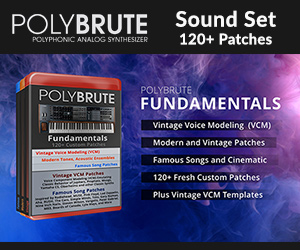PolyBrute Vintage Voice Modeling and Free Patches
Exploring vintage voice modeling on the PolyBrute
 PolyBrute – Vintage Voice Modeling
PolyBrute – Vintage Voice Modeling
We can achieve vintage style, per-voice offsets to virtually any parameter in the synth, by using the Voices mod source and Key/Seq mod source.
 VCM Preset Settings Recommendations:
VCM Preset Settings Recommendations:
1. Voice Distribution Mode:
Set this to "Centered" – this results in better performance, with better distributed voice values.
2. Voice Allocation Mode:
The voice allocation modes will have a significant effect on how the voice modeling plays out when you're playing chords or melodies. Different voice allocation schemes are good to model different classic/vintage style synths.
Round Robin: Use this for standard round robin voice cycling, like present in *most* modern synths. I would use this for most Oberheim and Vintage Moog type patches.
Reassign: This reassigns voices to the key they were last played on, where available. Use this type of voice allocation for vintage Prophet type behavior.
Reset: This resets and uses the lowest available voice. This can be used to replicate on of the voice modes on classic Jupiters.
Voice Modeling Basics:
At its most basic form, to achieve vintage voice modeling performance, I recommend routing:
Voices -> Pitch VCO1 (.03 semitones... use synth, not PBC)
Voices -> Pitch VCO2 (.06 semitones... use synth, not PBC)
Voices -> Master Cutoff (.004... use PBC, 1% or less on synth)
Voices -> Filter Attack (.040 on PBC, 4% on synth)
Voices -> Filter Decay (.040 on PBC, 4% on synth)
Voices -> Filter Release (.040 on PBC, 4% on synth)
Voices -> Amp Attack (.040 on PBC, 4% on synth)
Voices -> Amp Decay (.040 on PBC, 4% on synth)
Voices -> Amp Release (.040 on PBC, 4% on synth)
Note: The above values are just starting points. You can increase or decrease the values to your taste, depending on whether you want more subtle, or exagerrated vintage character.
By giving per-voice offsets to each of those parameters, it will introduce a huge amount of organic, lush, warm type of sound. The oscillator and filter cutoff offsets will introduce a subtle phasing ot the oscillators, which will create that sort of swirling vintage type of oscillator sound. The offsets to Attack, Decay and Release stages will provide temporal/time offsets to the animation of filter cutoff peaks and amp volume curve, providing a lot more organic sound.
In addition to the parameters listed above, you can target virtually any other parameters on the synth with per voice offsets. I target different aspects depending on what type of patch I'm creating. Other common parameters you might want to target: Env Sustain, Env Amounts, Key Tracking, LFO Rates, LFO Amounts, Filter Drive, Noise level, Osc Shape, Osc Pulse Width, among others.
Taking Voice Modeling to the Next Level
Intonation / Osc Scaling
Most older synths have per voice offsets to oscillator tuning that are based on oscillator scaling / intonation over multiple octaves on the keybed. Intonation is an effect where at lower octaves, a voice may be sharp, but as you progress up four or five octaves, that same voice may be flat. (or vice versa). I measured this effect in many vintage/classic synths. You can model vintage voice intonation by routing the Key/Seq destination to Osc Frequency 1/2.
Key/Seq -> Pitch VCO1 (-0.001 in PBC, 0.04 semitones on synth)
Key/Seq -> Pitch VCO2 (-0.005 in PBC, 0.20 semitones on synth)
Additional Parameters and Macro Behaviors
In addition to the core parameters recommended above, you can also give small offsets to resonance amounts, noise level, oscillator levels, oscilator shape variation, pulse width, envelope amounts, filter drive, filter levels, sustain amount, LFO parameters, Mod envelope stages, and basically any other parameter.
Further, you can model specific macro type behaviors on a per voice basis. For instance, one of the quirks that I measured in several vintage synths, and particular MemoryMoogs, was on some voices there was a pitch settle or chirp in the transient phase / early attack of certain oscillators on certain voices... this type of behavior can be modeled using the Mod Envelope, and then applied with per voice variance in the mod matrix.
Use for Acoustic Ensemble Patches
These offsets not only work great for capturing vintage 1970s/1980s poly synth type of character, but also make acoustic ensemble patches sound so much more realistic. For instance, String Ensembles, Brass Ensembles, Choir Patches, etc...